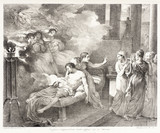Born in Guadeloupe, the illegitimate son of a white government official and a freed black slave, Guillaume-Guillon Lethière traveled to France in 1774 and entered the studio of Jean-Baptiste Descamps at the academy in Rouen. In 1777 he enrolled at the Académie Royale de Peinture et de Sculpture, Paris, as a pupil of Gabriel-François Doyen. Lethière received second place in the 1784 Prix de Rome. Although he never placed first, he was awarded a pension from the academy to study in Rome. Lethière remained in Rome from 1786 until 1790, returning in 1791 to Paris, where he opened a teaching studio in competition with Jacques-Louis David. Lethière exhibited regularly at the Paris Salon from 1793 to 1831. As an adviser to the nobleman and politician Lucien Bonaparte, he traveled to Spain in 1801. Following an altercation in Paris that resulted in the death of one soldier and the injury of another, the French government shut down Lethière’s studio, forcing him to leave the city. In 1807, with Bonaparte’s intervention, Lethière was appointed director of the Académie Française, in Rome. Returning to Paris in 1816, he was elected a member of the Institut de France in 1818 and awarded the Légion d’honneur. The following year he was appointed a professor at the École des Beaux-Arts. A revolutionary, many of Lethière’s paintings were political and perpetuated Neoclassical formulas well into the Romantic period.
Guillaume-Guillon Lethière
3 records
Include records without images
About this artist

